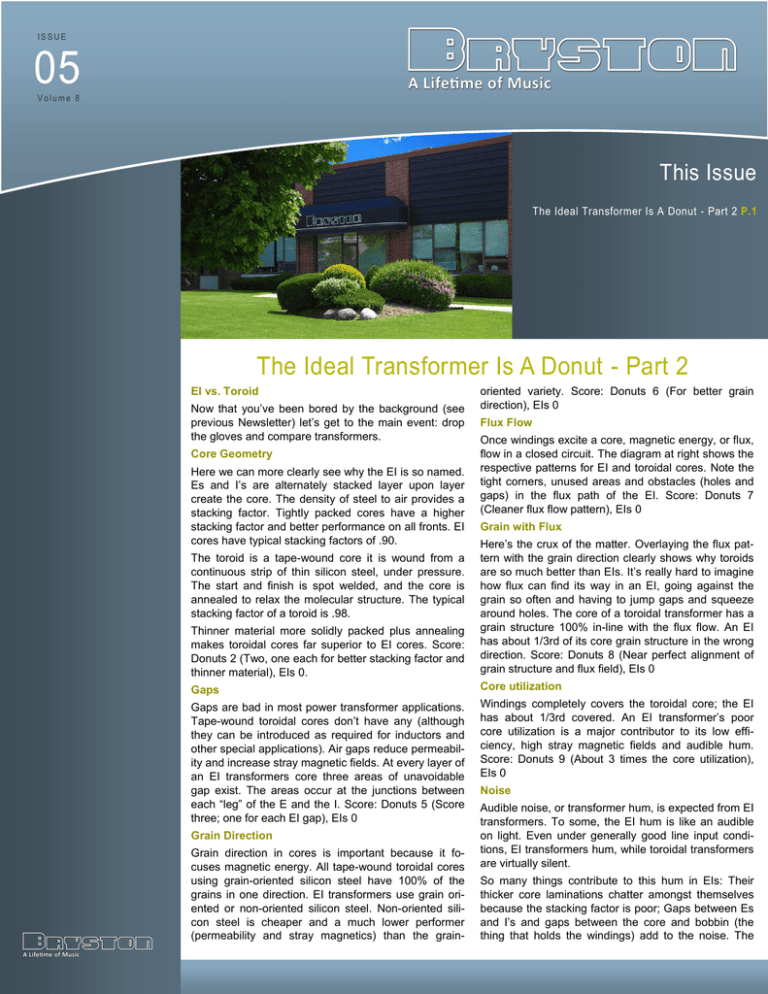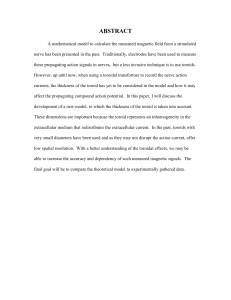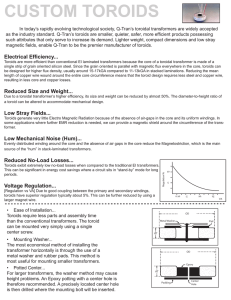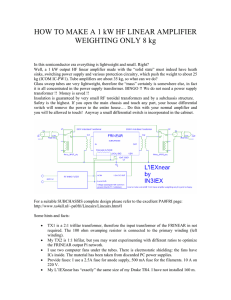The Ideal Transformer Is A Donut - Part 2
advertisement

ISSUE 05 Volume 8 This Issue The Ideal Transformer Is A Donut - Part 2 P.1 The Ideal Transformer Is A Donut - Part 2 EI vs. Toroid Now that you’ve been bored by the background (see previous Newsletter) let’s get to the main event: drop the gloves and compare transformers. Core Geometry Here we can more clearly see why the EI is so named. Es and I’s are alternately stacked layer upon layer create the core. The density of steel to air provides a stacking factor. Tightly packed cores have a higher stacking factor and better performance on all fronts. EI cores have typical stacking factors of .90. oriented variety. Score: Donuts 6 (For better grain direction), EIs 0 Flux Flow Once windings excite a core, magnetic energy, or flux, flow in a closed circuit. The diagram at right shows the respective patterns for EI and toroidal cores. Note the tight corners, unused areas and obstacles (holes and gaps) in the flux path of the EI. Score: Donuts 7 (Cleaner flux flow pattern), EIs 0 Grain with Flux Thinner material more solidly packed plus annealing makes toroidal cores far superior to EI cores. Score: Donuts 2 (Two, one each for better stacking factor and thinner material), EIs 0. Here’s the crux of the matter. Overlaying the flux pattern with the grain direction clearly shows why toroids are so much better than EIs. It’s really hard to imagine how flux can find its way in an EI, going against the grain so often and having to jump gaps and squeeze around holes. The core of a toroidal transformer has a grain structure 100% in-line with the flux flow. An EI has about 1/3rd of its core grain structure in the wrong direction. Score: Donuts 8 (Near perfect alignment of grain structure and flux field), EIs 0 Gaps Core utilization Gaps are bad in most power transformer applications. Tape-wound toroidal cores don’t have any (although they can be introduced as required for inductors and other special applications). Air gaps reduce permeability and increase stray magnetic fields. At every layer of an EI transformers core three areas of unavoidable gap exist. The areas occur at the junctions between each “leg” of the E and the I. Score: Donuts 5 (Score three; one for each EI gap), EIs 0 Windings completely covers the toroidal core; the EI has about 1/3rd covered. An EI transformer’s poor core utilization is a major contributor to its low efficiency, high stray magnetic fields and audible hum. Score: Donuts 9 (About 3 times the core utilization), EIs 0 The toroid is a tape-wound core it is wound from a continuous strip of thin silicon steel, under pressure. The start and finish is spot welded, and the core is annealed to relax the molecular structure. The typical stacking factor of a toroid is .98. Grain Direction Grain direction in cores is important because it focuses magnetic energy. All tape-wound toroidal cores using grain-oriented silicon steel have 100% of the grains in one direction. EI transformers use grain oriented or non-oriented silicon steel. Non-oriented silicon steel is cheaper and a much lower performer (permeability and stray magnetics) than the grain- Noise Audible noise, or transformer hum, is expected from EI transformers. To some, the EI hum is like an audible on light. Even under generally good line input conditions, EI transformers hum, while toroidal transformers are virtually silent. So many things contribute to this hum in EIs: Their thicker core laminations chatter amongst themselves because the stacking factor is poor; Gaps between Es and I’s and gaps between the core and bobbin (the thing that holds the windings) add to the noise. The necessary vacuum dampen the hum. varnishing can’t sufficiently To reduce the noise when EIs are installed into equipment, elaborate sub-chassis and shock mounting are sometimes employed. Toroids have little to contribute audibly. There core is much more tightly packed and of thinner material. There is no bobbin. Insulation and wire are tightly wound directly and completely over the core (the source of noise in transformers). Because a toroidal core can operate at higher permeability, it can easily be wound with higher numbers of turns to reduce to possibility of saturation, while still retaining all of its benefits over EI transformers. Score: Donuts 10 (Quieter under normal conditions), EIs 0 Efficiency Transformer inefficiencies are made of copper losses and iron losses. Copper losses refer to the windings (wire) and Iron losses refer to the core. Losses through the windings are almost completely from resistance and the product is heat. Core losses are from eddy currents, which are electrical and produce heat, and the physical movement, known as magneto striction, that usually creates noise. Toroidal transformers have higher permeability, gapless cores with thinner laminations and better grain geometry. This allows them to have fewer turns for a given voltage than EI transformers. Fewer turns at a given gauge of wire means lower resistance and less heat. The thinner laminations on a toroid mean much lower eddy current loss and under normal operation conditions, toroids do not convert energy into core noise, like EIs. Less loss of all kinds adds up to greater efficiency for toroids. Score: Donuts 12 (Score 2. More efficient in both core and winding losses.), EIs 0 Performance Lower copper loss means better regulation. (Regulation is the difference between loaded and unloaded output voltages.) Lower overall losses make for a cooler product, less thermal stress on surrounding components and longer transformer and product life. Score: Donuts 14 (Score two. Better regulation and cooler operating.), EIs 0 Size With other specifications approximately equal, a toroidal transformer can be less than the size and weight of an EI transformer. The core is smaller because it is higher in permeability, so higher in flux density. Because of these things, there is less copper. Less material: smaller size and lower weight. Score: Donuts 16 (Score two. Smaller and lighter.), EIs 0 DC Offset All power transformers work with AC. DC (direct current) cannot make the flux changes required to sustain a transferable magnetic field. Under normal conditions DC does not exist on power lines. However, because of nasty things like cheap lighting dimmer switches, sometimes a small DC component can occur on an AC line. Because toroidal cores are so efficient, they sustain magnetic flux easily. DC offset on an AC line will eventually cause the toroidal core to go into saturation by continually driving the core into one direction. This sounds bad both literally and figuratively. But, it’s rare and there are easy solutions. An EI transformer core has unavoidable gaps. These gaps are generally bad, both for stray magnetics and for overall efficiency. But, they do help here in a passive way. An EI core can’t sustain a magnetic field for long and any additional flux is sprayed out of its many gaps. So, in the rare cases of DC offset, EIs can distribute the additional flux into surrounding circuits. Toroids can be designed to take DC offset. This is usually only necessary for extreme applications, like interruptible power supplies. Another option is to add a simple DC blocking circuit on the primary side of the toroid. A few diodes and a couple of capacitors easily handle the small amount of DC that rarely gets onto AC lines. Many audio companies using toroidal transformers employ these simple circuits to enjoy the overall benefits of toroids. Score: Donuts 16, EIs 1 (Really shouldn’t count, but we don’t want to embarrass.) Off Load Losses Also as a direct result of core efficiency, toroids consume about 1/10th the energy of EI transformer when no load is present on the secondary. For many applications, where the equipment is on but often not oper- ating, energy savings can be substantial. But even if this direct specification is not capitalized, it is at least a very good indication of an extremely effective core. Score: Donuts 17 (Much lower quiescent current draw.), EIs 1 form as well as the EI in this narrow category. But, with proper fusing, or modest protection, or special attention at the time of design, in-rush is not an issue for a toroid. Score: Donuts 18, EIs 2 (A second arguable goal.) Stray Fields Conclusion EI transformers emit about 10 times as much energy in stray magnetic fields compared to toroids. These emissions can cause steel chassis to rattle and video screen images to jiggle or get grainy. They add noise to audio signals and any other signals in their proximity. Gaps and poor core utilization are the culprits. Toroids don’t have gaps and EIs can’t avoid them. A Toroid’s windings cover 100% of the core while an EI’s only covers a third. Score: Donuts 18 (For noninterference with surrounding equipment.), EIs 1 Toroids make better pucks than EIs. There is just no way is a clunky sharp-edged hulk of an EI going to slip as silkily down the ice as a nice toroid. Okay, with DC offset or in-rush, unprotected toroids perform marginally lower in these easily avoidable situations. But, let’s put it in perspective. In a properly engineered application, there are always trades and in the balance toroids are the hands-down performance winners. In equipment, and everywhere else, toroids are simply better than EIs. In Rush Remember the ideal transformer? It’s 100% efficient, no core losses, no winding losses, 0% load regulation, and no radiation of heat, or audible noise or magnetic field. No transformer’s ideal, but the toroid is miles ahead of the competition. It is the closest to 100% efficient because its core losses are negligible, so there are fewer turns per volt, which means shorter windings and less resistance. Thinner laminations, aligned grain and flux patterns and no gaps are what make the core clearly better and keep the radiation and noise down. Less resistance in the windings means less energy loss to heat and far better regulation. There is no mystique only fact, toroids are better than EIs. Toroids are quiet and toroids are cool. Toroids are donuts and everybody deserves donuts. And your equipment deserves the ideal transformer, a toroid. Toroidal cores stay magnetized once turned off. This again testifies to their efficiency, but if the transformer is turned back on during the same positive AC cycle, higher currents are drawn from the line. This condition is called in-rush and it only occurs if the conditions are just right and only for a maximum cycle (about 0.008 seconds). It is also not dangerous to the transformer or equipment and is easily rectified in the product - in most cases only a slow blow fuse is required. For higher power applications an NTC (negative temperature coefficient) resistor may be used. Toroids can also be designed to lower in-rush levels depending on the application. Again, inadvertently, due to the gaps in EIs, a standalone non-optimized toroidal transformer will not per- Bryston Ltd. 677 Neal Drive Peterborough, Ontario CANADA K9J 6X7 Phone: 705-742-5325 or 1-800-632-8217 Fax: 705-742-0882 Email: contact@bryston.com Web: http://www.bryston.com Editor: James Tanner, Vice President of Sales and Marketing Email: jamestanner@bryston.com




